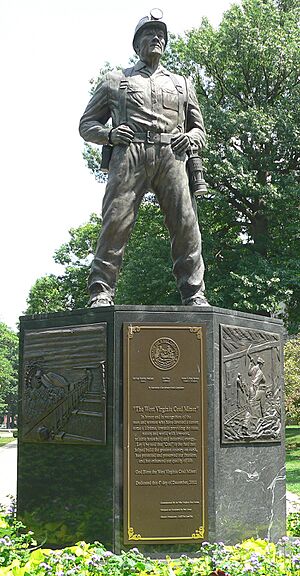Working class facts for kids
The working class is a term used to describe people in society who usually have jobs that involve physical work. These jobs are often paid by the hour, and they are generally not highly paid or academic.
What "working class" means can be a bit different in various societies. People started talking about the working class a lot after the industrialization period in the early 19th century. A famous thinker named Karl Marx wrote a lot about this group of people.
The working class is often compared to the middle class and the upper class. These classes are usually seen as having more money or different types of jobs. Below the working class, there is sometimes a group called the underclass.
Contents
What is the Working Class?
The working class includes people who do many important jobs every day. Think about construction workers, factory workers, cleaners, and many people who work in shops or restaurants. These jobs are essential for society to function.
These jobs often require practical skills and physical effort. They are different from jobs that require many years of university education, like doctors or lawyers.
History of the Working Class
The idea of the working class became very important during the Industrial Revolution. This was a time when many new factories and industries started. People moved from farms to cities to work in these factories.
Working conditions in these early factories were often hard. People worked long hours for low pay. This led to discussions about fairness and how society was organized. Thinkers like Karl Marx wrote about how the working class, or "proletariat," was a key part of this new industrial society.
Working Class and Other Social Groups
Society is often divided into different groups, or social classes, based on things like jobs, income, and education.
- The working class usually earns wages for their labor.
- The middle class often includes people with professional jobs, like teachers or office workers. They might earn salaries instead of hourly wages.
- The upper class usually has a lot of wealth and power, often from owning businesses or inherited money.
There is also a term called the underclass. This group faces many challenges and often has very low income or struggles to find stable work.
Related topics
- Apprentice: Someone learning a skilled trade.
- Constitution: A set of rules for how a country is governed.
- Globalization: How countries and people around the world become more connected.
- Minimum wage: The lowest amount of money an employer can legally pay workers.
- Social class: How people are grouped in society.
- Bourgeoisie: A term sometimes used for the middle or upper class, especially those who own businesses.
- Middle class: People with jobs that are often professional or managerial.
- Proletariat: Another term for the working class, especially in Marxist ideas.
- Upper class: People with significant wealth and social status.
- Trade union: An organization that helps workers protect their rights and improve their working conditions.
Images for kids
-
Working-class life in Victorian Wetherby, West Riding of Yorkshire, England.
-
Striking teamsters battling police on the streets of Minneapolis, Minnesota, June 1934.
See also
 In Spanish: Clase obrera para niños
In Spanish: Clase obrera para niños





